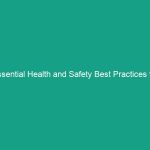Introduction
Good morning team! Today, we’re gathering to discuss a crucial topic in our daily operations: Essential Pulling Techniques and how to avoid common risks in HSE practices. Understanding these techniques is vital not just for compliance but for ensuring your Safety and the Safety of your coworkers.
Pulling tasks are common in various workplaces, and while they may seem straightforward, improper techniques can lead to serious injuries. Let’s dive into why mastering pulling techniques is essential for maintaining a safe and healthy work Environment.
Understanding Essential Pulling Techniques
Essential pulling techniques refer to the methods and practices used when pulling items, tools, or equipment in the workplace. These techniques are crucial in preventing injuries such as strains, sprains, and other musculoskeletal disorders that can arise from improper lifting and pulling.
Many people believe that as long as they are strong enough, they can pull heavy items without any specific technique. However, this misconception can lead to significant injuries and long-term health issues. Understanding how to pull correctly can protect your body and enhance your efficiency on the job.
Key Hazards, Risks, and Safety Considerations
When it comes to pulling techniques, several Hazards and risks can arise. Here are some of the primary concerns:
- Muscle Strains: Pulling heavy items without proper technique can lead to muscle strains, particularly in the back and shoulders.
- Slips and Falls: If the surface is uneven or wet, pulling can easily lead to losing your balance.
- Pinching Hazards: Pulling items close to your body can expose your fingers or hands to pinch points.
- Overexertion: Ignoring the weight of the load can lead to fatigue and increased risk of injury.
Ignoring these risks can result in real-world consequences, such as workplace injuries that may lead to lost time, decreased productivity, and increased insurance costs. It’s essential to be aware of these hazards and take preventive measures seriously.
Best Practices, Procedures, & Actionable Advice
Now that we understand the risks, let’s look at the Best Practices for safe pulling techniques:
1. Assess the Load
Before attempting to pull an item, assess its weight and size. If it’s too heavy or awkward, seek assistance or use mechanical aids.
2. Use Correct Body Mechanics
Always use your legs to generate power, not your back. Stand close to the load, bend your knees, keep your back straight, and pull with your legs while keeping your body aligned.
3. Maintain a Clear Path
Ensure the area where you are pulling is free of obstacles. This will help prevent slips, trips, and falls.
4. Communicate with Your Team
If you are working with others, communicate clearly. Use hand signals or verbal cues to ensure everyone is on the same page.
5. Take Breaks
Avoid overexertion by taking regular breaks, especially during physically demanding tasks. This helps reduce fatigue and lowers the risk of injury.
Real-World Example
Consider the case of a warehouse employee who attempted to pull a heavy cart alone. Ignoring proper techniques, he strained his back, leading to a long recovery period and lost workdays. By following safe pulling practices, he could have avoided this injury.
Regulations, Standards, and Compliance
It’s essential to follow relevant safety Standards, such as those set by OSHA (Occupational Safety and Health Administration) and ISO (International Organization for Standardization). These Regulations provide guidelines on Safe Practices and help ensure a safe working environment.
Compliance with these standards not only protects you and your coworkers but also helps the company avoid penalties and improve overall productivity. Understanding and following these regulations is not just a requirement; it’s a commitment to safety.
Employee Engagement & Discussion
Let’s take a moment to reflect on our current practices. What safety challenges have you encountered related to pulling tasks? Sharing your experiences can help us all learn and improve our safety protocols together.
Additionally, if you have suggestions for improving our pulling techniques or Safety Measures, we want to hear them. Your insights are invaluable in creating a safer workplace.
Conclusion & Key Takeaways
In conclusion, mastering essential pulling techniques is vital in avoiding common risks in HSE practices. Here are the key takeaways:
- Always assess the load before pulling.
- Use proper body mechanics to protect your back.
- Maintain a clear path to prevent accidents.
- Communicate effectively with your team.
- Take breaks to avoid overexertion.
By applying these practices, you contribute to a safer working environment for yourself and your colleagues. Thank you for your attention today, and let’s prioritize safety in everything we do!


